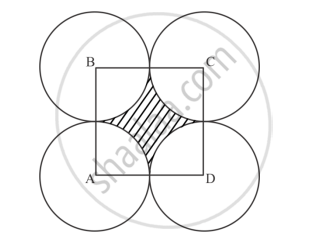Advertisements
Advertisements
Question
In fig. 7 is shown a disc on which a player spins an arrow twice. The fraction `a/b` is formed, where 'a' is the number of sector on which arrow stops on the first spin and 'b' is the number of the sector in which the arrow stops on second spin. On each spin, each sector has equal chance of selection by the arrow. Find the probability that the fraction `a/b>1.`

Solution 1
Elementary events associated with the experiment of spinning an arrow twice on a disc are
(1, 1), (1, 2), ...,(1, 6)
(2, 1), (2, 2), ...,(2, 6)
(3, 1), (3, 2), ...,(3, 6)
(4, 1), (4, 2), ...,(4, 6)
(5, 1), (5, 2), ...,(5, 6)
(6, 1), (6, 2), ...,(6, 6)
∴ Total number of elementary events = 36
It is given that a is the number of sector on which the arrow stops on the first spin and b is the number of the sector on which the arrow stops on the second spin.
Let A denote the event `a/b>1.`
Now,
`a/b>1Rightarrow a>b`
So, elementary events favourable to the event A are
(2, 1), (3, 1), (3, 2), (4, 1), (4, 2), (4, 3), (5, 1), (5, 2), (5, 3), (5, 4), (6, 1), (6, 2), (6, 3), (6, 4) and (6, 5)
∴ Total number of favourable events = 15
Thus,
Required probability =`"(The number of favourable events)"/"(Total number of the events)"=15/36 =5/12`
Solution 2
Elementary events associated with the experiment of spinning an arrow twice on a disc are
(1, 1), (1, 2), ...,(1, 6)
(2, 1), (2, 2), ...,(2, 6)
(3, 1), (3, 2), ...,(3, 6)
(4, 1), (4, 2), ...,(4, 6)
(5, 1), (5, 2), ...,(5, 6)
(6, 1), (6, 2), ...,(6, 6)
∴ Total number of elementary events = 36
It is given that a is the number of sector on which the arrow stops on the first spin and b is the number of the sector on which the arrow stops on the second spin.
Let A denote the event `a/b>1.`
Now,
`a/b>1Rightarrow a>b`
So, elementary events favourable to the event A are
(2, 1), (3, 1), (3, 2), (4, 1), (4, 2), (4, 3), (5, 1), (5, 2), (5, 3), (5, 4), (6, 1), (6, 2), (6, 3), (6, 4) and (6, 5)
∴ Total number of favourable events = 15
Thus,
Required probability =`"(The number of favourable events)"/"(Total number of the events)"=15/36 =5/12`
APPEARS IN
RELATED QUESTIONS
The probability that a number selected at random from the numbers 1, 2, 3, ..., 15 is a multiple of 4, is
`(A)4/15`
`(B)2/15`
`(C)1/5`
`(D)1/3`
In below Fig., points A, B, C and D are the centers of four circles that each have a radius of length one unit. If a point is selected at random from the interior of square ABCD. What is the probability that the point will be chosen from the shaded region?

A box contains 5 red marbels, 8 white marbles and 4 green marbles, One marble is taken out of the box at ramdom. What is the probability that the marble taken out will be white?
All kings and queens are removed from a pack of 52 cards. The remaining cards are well shuffled and then a card is randomly drawn from it. Find the probability that this card is a red face card
Two different coins are tossed simultaneously. The probability of getting at least one head is
In a family of 3 children, find the probability of having at least one boy.
A game of chance consists of spinning an arrow which is equally likely to come to rest pointing to one of the numbers 1, 2, 3,..., 12 as shown in the figure. What is the probability that it will point to an even number ?
A lot consists of 144 ballpoint pens of which 20 are defective and others good. Tanvy will buy a pen if it is good, but will not buy it if it is defective. The shopkeeper draws one pen at random and gives it to her. What is the probability that she will not buy it?
Cards numbered 1 to 30 are put in a bag. A card is drawn at random from the bag. Find the probability that the number on the drawn card is not divisible by 3,
All kings, queens and aces are removed from a pack of 52 cards. The remaining cards are well-shuffled and then a card is drawn from it. Find the probability that the drawn card is a red card.
A die is thrown once. The probability of getting an odd number greater than 3 is
If A = {1, 2, 3, 4, 5} and B = {1, 3, 7}, then A ∩ B = ?
A bag contains 15 balls, out of which some are white and the others are black. If the probability of drawing a black ball at random from the bag is `2/3`, then find how many white balls are there in the bag.
In a single throw of a die, find the probability of getting :
(i) 8
(ii) a number greater than 8
(iii) a number less than 8
From 10 identical cards, numbered 1, 2, 3, ……, 10, one card is drawn at random. Find the probability that the number on the card drawn is a multiple of
3
A coin is tossed once. Find the probability of getting a head
What is the probability that the minute and hour hands of a clock will form an acute angle at any given time?
In a family having three children, there may be no girl, one girl, two girls or three girls. So, the probability of each is `1/4`. Is this correct? Justify your answer
On throwing a dice once, the probability of occurence of an even number is `1/2`.
One or more outcomes of an experiment make an event.
